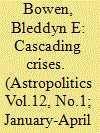| Srl | Item |
| 1 |
ID:
130045


|
|
|
|
|
| Publication |
2014.
|
| Summary/Abstract |
The term space security is often used, but seldom analyzed. This is a significant gap in the literature of space politics, as it posits considerable implications for debates on how to deal with a runaway growth in the space debris population, and how we argue for or against space weaponization. Securitizing all threats in space may lead to greater difficulties in enacting debris removal measures, as these systems are inherently dual-use. A case is made for keeping space security in its traditional connotations of national security so that environmental issues related to orbital debris can be resolved with reduced security concerns in a space development framing.
|
|
|
|
|
|
|
|
|
|
|
|
|
|
|
|
| 2 |
ID:
132564


|
|
|
|
|
| Publication |
2014.
|
| Summary/Abstract |
Low earth orbit has become increasingly congested as the satellite population has grown over the past few decades, making orbital debris a major concern for the operational stability of space assets. This congestion was highlighted by the collision of the Iridium 33 and Cosmos 2251 satellites in 2009. This paper addresses the current state of orbital debris regulation in the United States and asks what might be done through policy change to mitigate risks in the orbital debris environment. A brief discussion of the nature of orbital debris addresses the major contributing factors including size classes, locations of population concentrations, projected satellite populations, and current challenges presented in using post-mission active debris removal to mitigate orbital debris. An overview of the current orbital debris regulatory structure of the United States reveals the fragmented nature of having six regulating bodies providing varying levels of oversight to their markets. A closer look into the regulatory policy of these agencies shows that, while they all take direction from The U.S. Government Orbital Debris Mitigation Standard Practices, this policy is a guideline with no real penalty for non-compliance. Various policy solutions to the orbital debris problem are presented, ranging from a business as usual approach to a consolidated regulation system which would encourage spacecraft operator compliance. The positive aspects of these options are presented as themes that would comprise an effective policy shift towards successful LEO conservation. Potential economic and physical limitations to this policy approach are also addressed.
|
|
|
|
|
|
|
|
|
|
|
|
|
|
|
|
| 3 |
ID:
186203


|
|
|
|
|
| Summary/Abstract |
Massive chain reaction among the orbital debris population, also known as Kessler Syndrome, is generally perceived as a universally hostile scenario. However, the article argues that intentional massive pollution of orbits might be a tool in weak space powers’ strategic arsenal. Given the technological restrictions and irreversible escalatory potential of such a step, its utilization is, nonetheless, extremely limited. It is argued that total spoiling of the utilization of space services and access to outer space would be viable only to a very low number of actors in scenarios of grave threat to their existence, territorial integrity or survival of their regimes.
|
|
|
|
|
|
|
|
|
|
|
|
|
|
|
|